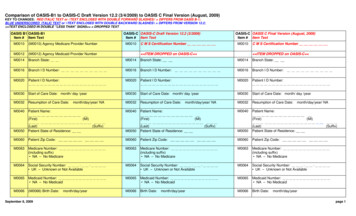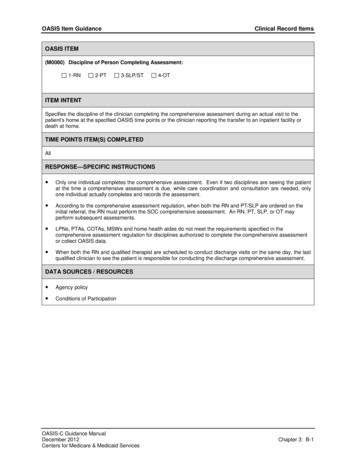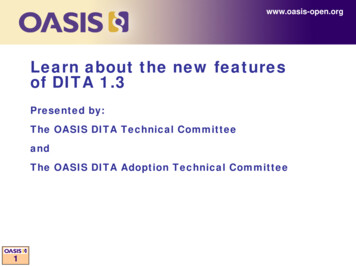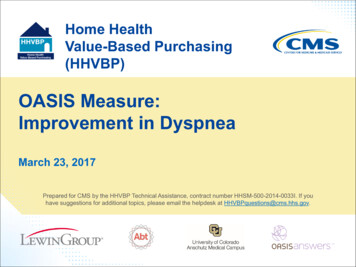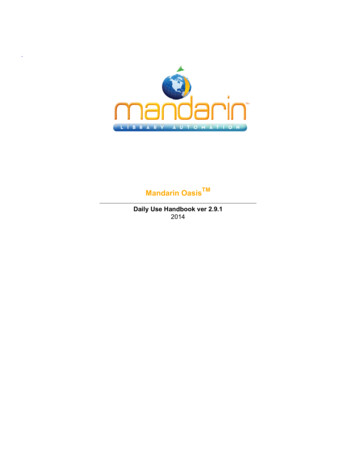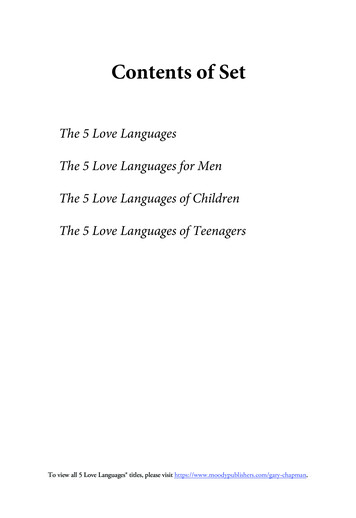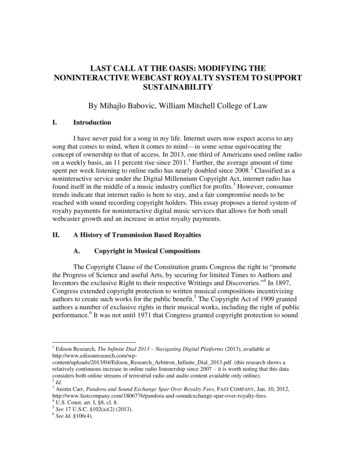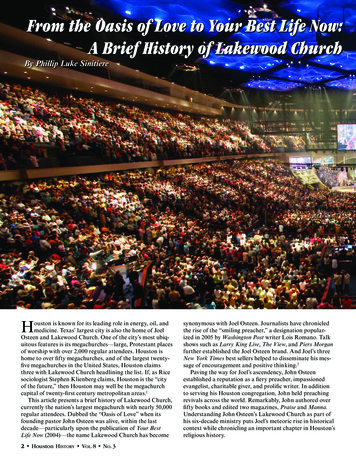
Transcription
From the Oasis of Love to Your Best Life Now:A Brief History of Lakewood ChurchBy Phillip Luke SinitiereHouston is known for its leading role in energy, oil, andmedicine. Texas’ largest city is also the home of JoelOsteen and Lakewood Church. One of the city’s most ubiquitous features is its megachurches—large, Protestant placesof worship with over 2,000 regular attendees. Houston ishome to over fifty megachurches, and of the largest twentyfive megachurches in the United States, Houston claimsthree with Lakewood Church headlining the list. If, as Ricesociologist Stephen Klienberg claims, Houston is the “cityof the future,” then Houston may well be the megachurchcapital of twenty-first century metropolitan areas.1This article presents a brief history of Lakewood Church,currently the nation’s largest megachurch with nearly 50,000regular attendees. Dubbed the “Oasis of Love” when itsfounding pastor John Osteen was alive, within the lastdecade—particularly upon the publication of Your BestLife Now (2004)—the name Lakewood Church has become2 Houston History Vol.8 No.3synonymous with Joel Osteen. Journalists have chronicledthe rise of the “smiling preacher,” a designation popularized in 2005 by Washington Post writer Lois Romano. Talkshows such as Larry King Live, The View, and Piers Morganfurther established the Joel Osteen brand. And Joel’s threeNew York Times best sellers helped to disseminate his message of encouragement and positive thinking.2Paving the way for Joel’s ascendency, John Osteenestablished a reputation as a fiery preacher, impassionedevangelist, charitable giver, and prolific writer. In additionto serving his Houston congregation, John held preachingrevivals across the world. Remarkably, John authored overfi fty books and edited two magazines, Praise and Manna.Understanding John Osteen’s Lakewood Church as part ofhis six-decade ministry puts Joel’s meteoric rise in historicalcontext while chronicling an important chapter in Houston’sreligious history.
After contract negotiations and a Houston City Council vote, Lakewood Church moved into the former Compaq Center in July 2005.Lakewood Church seats 16,000 people and a typical weekend welcomes nearly 50,000 attendees. In May 2010, Lakewood completed thepurchase of its property for 7.5 million.Photo courtesy of Lakewood Church.findinG faiTh in fOrT wOrTh and The hOLy spiriT inhOusTOnIt was 1939. World War II commenced with Hitler’s blitzkrieg invasion of Poland. African American singer BillieHoliday recorded “Strange Fruit,” a haunting song aboutthe brutality of lynching. The classic fi lm The Wizard ofOz appeared in theatres. And John Steinbeck publishedhis Depression-era, Pulitzer Prize winning novel Grapes ofWrath, capturing the rugged realities of economic calamity.In 1939, John Osteen, a seventeen-year-old theatre employee and frequent nightclub patron, found an anchor forhis wandering heart. After the patient prodding and faithfulevangelism of a boyhood friend named Sam Martin, Osteenrecalled in an autobiography, Rivers of Living Water (1975),that at a Southern Baptist church in Fort Worth, “I sur-rendered all to the Lord Jesus and passed from death intolife. I became a new creature in Christ Jesus.” In anotherautobiographical testimony in 1977, Osteen claimed that asa teenager he was “living for the world,” but upon considering the possibility of his eternal future responded to an altercall and “gave Jesus Christ my heart.”3John Osteen’s conversion in 1939 took him to churchesand other venues throughout the U.S. where he wouldpreach, asking others to find faith in Jesus. A committed Baptist, Osteen’s newfound faith proved inspirationalon other levels. He completed a bachelor’s degree at JohnBrown University, and his 1944 Master’s thesis at NorthernBaptist Theological Seminary explored the formalitiesof the Baptist Sunday morning service and formulated astrategy for Christian education curriculum. Osteen appliedHouston History Vol.8 No.3 3
these insights as an assistant pastor at First Baptist Churchin San Diego, then in the late 1940s as a minister at FirstBaptist Church in Hamlin, Texas. During Osteen’s tenure inHamlin, church membership increased by 400 people andnearly 150 members were baptized. A deacon remarked thatOsteen was “sound in doctrine, humble and always willingto be led of the Lord.” Osteen left Hamlin in 1948 to becomea traveling preacher, inaugurating a lifelong itinerancy. Buta year later, he quickly found steady employment as pastorat Central Baptist Church in Baytown, Texas.4Success marked Osteen’s tenure. He expanded CentralBaptist’s Christian education program and classroom spacein addition to inaugurating a building program that resultedin the construction of an 800-seat sanctuary. Moreover,Osteen played a leading administrative role in the SanJacinto Baptist Association from 1950-1955. He served onmultiple missionary committees, including a program focused on evangelism in Mexico. Osteen left Central Baptistin 1956, his resignation likely the result of marital unrestthat led to a divorce. He nevertheless continued to ministerin official capacities in the late 1950s. At Hibbard MemorialBaptist Church, Osteen added a new building, and under hispreaching membership had soared to nearly 1,000. However,new and ecstatic religious experiences in 1958 along withmodifications in theological beliefs led to Osteen’s resignation. The following year Osteen founded LakewoodChurch.5The first daughter of John and Dodie Osteen entered theworld in 1958 with what appeared insurmountable healthproblems. Both doctors and parents feared Lisa would neverhave full mobility of her limbs nor live at full mental andcognitive capacities. “When our little girl was born we sawimmediately she was not a normal child,” Osteen wrote in1961, “We thought her neck was broken. She couldn’t holdup her head. She couldn’t hold her arms up. She couldn’thold her legs up. She was just a little blob of quivering flesh.”In desperation, John started to study the concept of physical healing in the New Testament and began to imagine thepossibility that Lisa could be healed. In time, Lisa began tolead an active, normal life, something Osteen attributed todivine influence and supernatural activity. These changingconvictions, which contrasted sharply with Southern Baptistteaching, proved instrumental in Osteen experiencing whathe called “baptism of the Holy Ghost.” After reading theNew Testament account of Pentecost in Acts 2, at a prayerretreat in Houston, Osteen exhibited glossolalia. This termrefers to speaking in tongues, and is a defining religious experience for Pentecostal, or charismatic Christians. Osteen’semerging charismatic Christianity began to reshape hissermons and books, which largely focused on speaking intongues and offering reports of physical healing. Osteenbrought this message to his church in Houston, and, in time,traveled far and wide to teach about spiritual power.6“penTeCOsT is nOT a denOminaTiOn BuT anexperienCe frOm GOd fOr everyOne”Attaining more flexibility, John Osteen began to operateoutside of a denominational framework. Although he hadbeen preaching for nearly two decades, in 1961 Osteen leftLakewood Church to pastor Marvin Crow and began to4 Houston History Vol.8 No.3One of John Osteen’searliest publications.Complementingthe contents of hismagazine Praise,Osteen’s bookspublished in the early1960s emphasizedhealing, speaking intongues, and othercharismatic gifts.Photo by author.travel the world. He held revival meetings in India, Europe,the Philippines, and Mexico. He plugged into existingneopentecostal preaching networks, collaborating withTulsa-based healing evangelists such as T. L. Osborn andOral Roberts. Osteen published several articles in Osborn’sministry magazine Faith Digest throughout 1961 and 1962.He pledged support for Osborn’s Juarez, Mexico, preachingtour and discussed Osborn’s revival in Houston. In thesearticles Osteen revealed that Osborn’s book Healing the Sick“showed [me] how to believe” in divine healing in relationto his daughter’s health concerns. So Osteen was excited tohost Osborn in Houston; he longed for Osborn’s messageto take root in a city he believed was overly concerned with“wealth and sophistication.” “Thousands of other attractions beckoned nightly,” Osteen observed, “for the attentionof the Gospel hardened multitudes in this great city.” Osteenwas not disappointed. “I was trembling with emotion asth[e] first service ended,” he said. “The mighty Word of Godhad its effect anew upon me” as Baptists and Methodists experienced healing, including members from Osteen’s formerBaytown church. Not only did Faith Digest introduce an unknown Houston healing evangelist to readers, but Osteen’sarticles, under Osborn’s ministry, further legitimated hisplace among neopentecostals, which historian David EdwinHarrell calls “new breeds.”7Much like other independent ministers, Osteen established his own evangelistic agency that distributed materials, solicited donations, and organized preaching revivals.Between 1961 and 1964, for example, Osteen publishedfive books on the work of the Holy Spirit and divine healing. In many of these early works Osteen interweaved hisown personal transformation from a rational-mindedSouthern Baptist to passionate charismatic. The John H.Osteen Evangelistic Association began to distribute Praise,a bimonthly periodical. Osteen often reminded readers, as he did on the fall 1964 cover: “Pentecost is Not aDenomination but An Experience from God for Everyone(Acts 2:39).”8In addition to Osteen’s publishing ventures, his impassioned, mature preaching impressed established minis-
John and Dodie Osteen often ministered together at LakewoodChurch and throughout the world. Dodie remains a formidablepresence at Lakewood by leading a weekly healing service, speakingat Evening of Hope events, and sharing her testimony of divinehealing.Photo courtesy of Lakewood Church.ters. His horizons widened further when he met DemosShakarian, the founder and leader of the Full GospelBusiness Men’s Fellowship International (FGBMFI).Shakarian founded the FGBMFI in the 1950s to provide aplace of worship, fellowship, and encouragement for working men and women of Pentecostal conviction. Osteen firstmet Shakarian through Houston businessman A. C. Sorelle,who sent Osteen to an FGBMFI meeting in Los Angeles. Inthe summer of 1963, the FGBMFI held its annual convention at the Shamrock Hotel in Houston. Osteen soon became a regular speaker at FGBMFI meetings and continuedhis involvement with the organization into the 1980s.9Achieving national stature in post-World War II charismatic circles throughout the 1960s and 1970s, Osteen published a dozen books and Lakewood Church expanded itsworship space twice. In 1972, Lakewood’s sanctuary grewto seat 500, and in 1979, the church expanded to accommodate 5,000 members. This exponential growth was a sign ofthings to come.10The Oasis of LoveThe growth of Lakewood Church in the 1980s mirroredthe prosperity associated with Houston’s oil boom. JohnOsteen became a televangelist, and by the decade’s end,when Houston’s oil fortunes plummeted, Lakewood openeda new sanctuary. Finally, the “Oasis of Love,” as Lakewoodbecame known in the 1980s, emerged as one of the leadingchurches in Word of Faith Movement (WOFM).11John added another family member to Lakewood’soperations when Joel left Oral Roberts University in 1982 tohelp his father start a television ministry. John’s friendshipwith televangelist Oral Roberts proved useful as a team ofRoberts’s producers assisted the church in establishing apresence in local, national, and international television markets. John became a fixture on local religious television. Amarketing campaign, extensive mailing list, and distributionnetworks allowed the dissemination of Osteen’s messagesat home and abroad. But it was often Houstonians whomost felt the impact of his television ministry. For example,Osteen’s message resonated with Houston federal judge andDemocrat Woodrow B. Seals, a committed and influentiallayperson at St. Stephen’s United Methodist Church. “Mydear Brother Osteen,” Seals began an April 1987 letter; “Iturned on the television Saturday night while I was preparing my church school lesson for Sunday [and] you werewalking out to that small pulpit and starting a sermon.”Despite a condescending tone about the working-classneighborhood where Lakewood was located, Seals foundOsteen’s sermon meaningful. “Like everyone in Houston, Ihave noticed those bumper stickers, ‘Lakewood Church—Oasis of Love,’ for two or three years.” Seals continued, “Ihave always wondered how anyone could start a church outwhere you started yours. But after hearing your sermonSaturday night I agreed with everything you said, and I especially appreciated what you said two or three times, ‘TellThrough the magazinePraise, the John H.Osteen EvangelisticAssociation documentedthe post-World War IIneopentecostal revivalduring the early 1960s.John reported associationnews, advertised books,and provided storiesof baptism in the HolyGhost and divine healing.Courtesy of Holy SpiritResearch Center, OralRoberts University.the untold and reach the unreachable.’” Seals again mentioned the Lakewood bumper stickers as a testimony to anactive and vibrant church. “[T]he Lord is raising up peoplelike you who will save the world,” he said.12Lakewood’s numerical growth in the 1980s necessitatedthe construction of a new building in 1987 to seat over 8,000members. The dedication ceremonies lasted a week in earlyApril 1988. A full-page ad in the Houston Post featureddistinguished invitees such as Mayor Kathy Whitmire,Congressman Jack Fields, along with leading CharismaticsOral Roberts, Kenneth Hagin, and T. L. Osborn. ProminentHouston clergy who made the ad included First UnitedMethodist’s William H. Hinson and Second Baptist’s EdwinYoung. Coupled with the publication of Osteen’s two dozenbooks in the 1980s, Lakewood became Houston’s premierHouston History Vol.8 No.3 5
Lakewood Church as it looked during the 1970s. The church grew significantly under John’s ministry, expanding its worship space twice, sothat by 1979 the sanctuary could accommodate 5,000 members.Photo courtesy of Lakewood Church.church and served as a model megachurch across the nationand throughout the world.13Lakewood Church’s growth allowed John to launchthe Lakewood Bible Institute (LBI) in the mid-1980s. Anunaccredited school devoted to biblical training from acharismatic perspective, LBI offered classes for lay-peoplein New Testament, Old Testament, principles of Bible study,healing, spiritual growth, faith, conversion, and prayer. Inaddition to daily chapel services, students were required toattend all of Lakewood’s missions and pastor’s conferences,and taping of Lakewood broadcasts. LBI promised that students “would learn how to apply the life-changing truths ofGod’s Word in a practical way . . . you’ll enjoy Spirit-filledservices while you learn in a supernatural atmosphere ofworship, teaching, and world evangelism.” LBI also provided unique access “to observe firsthand the pastoral ministryof John Osteen and learn from his powerful message offaith and great love.” Osteen served as LBI’s president andemphasized practical application of religious knowledge.While LBI did not survive the 1980s, it served as one manifestation of Osteen’s focus on Christian education.14In the 1980s, Osteen family circumstances tested nervesand stretched faith. The family’s faith in redemption andbelief in second chances fueled persistent convictions thattroubles would always turn around for the better. LisaOsteen, one of her father’s assistant ministers, underwentmarital difficulties that ended in divorce. Raised on herfather’s teaching, Lisa turned tragedy into triumph by publishing Six Lies That the Devil Uses to Destroy Marriages(1988). This book attributed marital strife to demonic influence and counseled regular, consistent prayer as a remedy.Lisa taught this philosophy under Lakewood’s marriageenrichment program.6 Houston History Vol.8 No.3Survival also marked Dodie Osteen’s life. The mother offive children and a regular minister by her husband’s side,Dodie was diagnosed with cancer in 1981, and doctors gaveher only a short time to live. Just as the couple prayed fortheir daughter, John and Dodie’s charismatic faith shapedthe prayerful response to this situation. Medical professionals eventually gave Dodie a clean bill of health, unable tofind cancer. Relieved, the Osteens attributed these medicalreports to divine intervention and passages about healingfound in the Bible. In her autobiography, Healed of Cancer(1986), Dodie wrote, “The Word of God is extremely important to people who are fighting a battle with their health,for often it’s the only hope they have. I know I would havedied if it had not been for the Bible.” Dodie also linked herhealing to verbal confession of Bible verses. “Day by day,”she remembered, “I gained hope and encouragement fromthe precious promises that God revealed to me through HisWord. I clung to my Bible and its healing promises.” Whilethe Osteens emphasized the spiritual dimensions of her boutwith cancer, the family’s Houston residence proved fortuitous as increased funding and research allowed doctors to“make cancer history” at M. D. Anderson Cancer Center.15From Generation to GenerationLakewood Church’s history took another historical turn inJanuary 1999 when John Osteen died of a heart attack. Johnhad often asked Joel to preach, yet Joel routinely dismissedthe suggestion, wishing to focus on the church’s behindthe-scenes duties. “I always loved working in production,”Joel reflected in 2004, “with the cameras and editing and allthat, even when I was a teenager.” Although Lakewood’sministerial leadership team ordained Joel in 1992, he neverexpected to assume pastoral responsibilities. In the midstof his 1999 illnesses, John asked his son once again to fill
in one Sunday; again Joel adamantly refused. Joel wrote inYour Best Life Now:Daddy’s words kept flitting through my mind,and with no other provocation, I began to havean overwhelming desire to preach. I didn’t reallyunderstand it at the time, but I knew I had todo something. Keep in mind, I had never evenprepared a sermon, let alone considered standingup in front of thousands of people to speak . Istudied all week and prepared a message, and thenext Sunday I spoke at Lakewood Church for thefirst time.Not only did the congregation welcome the newer Osteenwith open arms and rapturous applause, his siblings LisaComes and Paul Osteen, also ministers at Lakewood, quickly confirmed his ministerial calling. Reticent to embrace theministerial task of his father, Osteen submitted to what henow believes is his life’s calling.16Building on his father’s legacy, Joel retained aspects ofJohn’s ministerial vision. For example, Joel situated a rotating globe behind the pulpit at Lakewood, signifying thechurch’s commitment to evangelism and missionary outreach. Joel has maintained the “This is my Bible” confession at the beginning of services, a Lakewood tradition Johnstarted in the 1980s. “My dad’s whole message was that youcan rise higher,” Joel writes, “you can overcome, and withGod all things are possible. He lived it out before us, and formore than forty years he pastored Lakewood Church withgreat love and faithfulness.” Joel’s calling has transcendedJohn’s work too. Lakewood experienced exponentialgrowth on many levels—virtually embodying sociologistJoe Feagin’s description of Houston as a “free enterprisecity.” Most notably, Osteen helped to obtain an initial leaseof the Compaq Center for 12 million over thirty years,and the church agreed to spend approximately 90 millionto renovate the former sports arena, which seats 16,000people. In May 2010, Lakewood completed the purchaseof its property for 7.5 million. Moving from its workingclass roots to the upscale Greenway Plaza area, Lakewoodchurch opened in its new location in July 2005. “For nearlythirty years they’ve crowned champions in the sports field inthis building,” preached Joel at Lakewood’s grand openingservice, “but I believe for the next thirty years we can crownpeople champions in life. We’re going to let them know thatthey are victors and not victims, we’re going to let themknow they can do all things through Christ.” While Johnonce said he’d eventually preach in the Astrodome, his sonfulfilled that dream on a much larger scale.17Not only has Lakewood Church increased in numbers,the dissemination of Joel’s message has followed publication paths blazed by his father. To date Osteen has published three New York Times best sellers. Joel’s wife andLakewood co-pastor, Victoria Osteen, has found her nicheas well, with a self-help book for women along with a seriesof children’s books. In 2012, Lisa Osteen Comes, Joel’ssister, will publish her first book in over two decades. Fromone generation to the next, the family’s message of faith,forgiveness, and second chances has impacted Houston andthe world.The creation of “Evening with Joel” events in 2004marks another way that Joel expanded Lakewood’s reach.Regularly sold out, these events consist of a concert byLakewood’s musicians, Dodie’s testimony of healing (orone by another special guest), a recitation of Lakewood’shistory, and Joel’s message of God’s plan for self-improvement. The inaugural event took place at Madison SquareGarden in 2004, the site of Billy Graham’s 1957 revivals.More recently, the monthly services were renamed “Eveningof Hope,” with well-publicized events at Dodger Stadium,Yankee Stadium, and, in early 2011, in Jerusalem. Other“Evening of Hope” events took place in Killeen (2006)and Corpus Christi (2011). Joel succeeding in establishingthe camp meeting of the twenty-first century by holdingmonthly services at arenas in select U.S. cities and aroundthe world.18While Lakewood maintains the multiracial compositionthat John ushered in during the 1970s after Houston’s civilrights struggles, acquiring the Compaq Center allowed thechurch to expand its thriving Spanish ministry. In a strategic move in 2002, Joel hired Latin Grammy Award winner Marcos Witt. An accomplished musician and talentedspeaker, Witt was an established presence in Latin Americawho expanded Lakewood’s Spanish service. Born in SanAntonio, Witt grew up in Durango, Mexico, where hisparents worked as missionaries. After Witt’s father died,his mother remarried and continued to preach in Mexico.With a name many Spanish speakers recognize, Witt rarelygets enough credit for solidifying Lakewood’s presence inHouston—particularly since Houston is a hub for LatinAmerican immigration. Below the surface, Witt’s hire hada deeper connection to Lakewood Church’s history. In the1960s, Witt’s parents spoke at Lakewood about plans toKnown as the “smiling preacher,” Joel Osteen’s messages emphasizeself improvement, second chances, and faith that God can changeone’s circumstances. Joel’s teaching is broadcast on major television networks, available at iTunes, and published in three New YorkTimes best sellers: Your Best Life Now (2004), Become a Better You(2007), and It’s Your Time (2009).Photo courtesy of Lakewood Church.Houston History Vol.8 No.3 7
travel to Mexico, and John Osteen was “stirred and moved”to help with a 600 offering toward their missionary endeavors. Witt stated, “The seed that Lakewood sowed in thatministry lives to this day.” Witt is also an author who writesabout Christian leadership, music, and spiritual growth.19Despite these successes, the growth Lakewood Churchhas experienced under Joel has also precipitated a flurry ofcriticism. Critics spoke up most forcefully beginning in 2005after Joel’s appearance on Larry King Live. The extent towhich critics analyze Osteen’s ministry attests to his popularity, and offers an alternative way to document his riseto fame. Moreover, it complicates the public image of thesmiling preacher: Osteen is not passive when it comes to hiscritics. Armed with determination and biblical passages,Osteen responds by invoking the ministries of the ApostlePaul and Jesus Christ.20When pressed about the eternal fate of non-Christianson Larry King Live, Joel’s answer that it was in God’s handsleft evangelical viewers unsatisfied, suspicious, and angry.Many balked that Joel did not emphasize the Christianclaim that salvation centers on Jesus Christ. In the days thatfollowed, Osteen received numerous phone calls, questions,and complaints regarding his statements. After reading theprogram’s transcript, Osteen posted a letter on his websiteapologizing for his unclear statements. He stated categorically his convictions about the evangelical doctrine of salvation. “It was never my desire or intention to leave any doubtas to what I believe and Whom I serve,” Osteen wrote. “Ibelieve with all my heart that it is only through Christ thatwe have hope in eternal life. I regret and sincerely apologizethat I was unclear on the very thing in which I have dedicated my life .I believe that Jesus Christ alone is the onlyway to salvation.” Chastised and true to his philosophy ofministry, Osteen promised, “I will use this as a learningexperience and believe that God will ultimately use it for mygood and His glory.” Osteen observed, “I am comforted bythe fact that He sees my heart and knows my intentions. Iam so thankful that I have friends, like you, who are willingto share their concerns with me.” The following December,Osteen again appeared on Larry King Live. King noted thecontroversy surrounding Osteen’s earlier comments, in effect giving the humbled minister a second chance. “I believethat Jesus is the only way to heaven,” Osteen reiterated, “Ibelieve in a personal relationship with Christ the foundation of the Christian faith is that Christ came as a sacrificeso that we can receive forgiveness So I do believe that.It’s the foundation of our faith.” Despite Osteen’s clarification of his beliefs, critics continue to lambast his messageas shallow. Evangelicals such as John MacArthur, HankHanegraaff, and Michael Horton tackle Osteen’s messagein sermons and books, cautioning followers to steer clear ofOsteen’s “cotton candy gospel.”21Closer to home, theologian, minister, and seminaryprofessor J. B. Hixson is one of Osteen’s foremost Houstoncritics. Preaching at Brenham Bible Church just outsideHouston, he is a dean and professor of systematic theologyat Grace Theological Seminary and utilizes this area ofexpertise to analyze Osteen.22Hixson’s self-published book, Getting the Gospel Wrong:The Evangelical Crisis No One Is Talking About (2008), is a8 Houston History Vol.8 No.3study of evangelical ideas about salvation. Hixson decriesthe WOFM because the prosperity gospel “elevates personal prosperity to a place of centrality in the gospel.” Itemphasizes the power of faith itself rather than the object offaith in evangelical teaching, Jesus Christ. “Because reaching one’s full potential is couched in terms of a declarativeattitude of the heart,” writes Hixson, “the reader is inclinedto think that eternal salvation is likewise built upon thepower of positive thinking.” According to Osteen, one canfind peace and happiness in life simply by asking Jesus tocome into his heart and making Him his Lord and Savior.”Therefore, in Hixson’s view, Osteen “mischaracterizes faith”because he calls it a “conception of the mind” rather thanan act of trust in an object of faith.23Osteen’s most persistent critics highlight Joel’s appearance on Larry King Live. By singling out Joel’s missteps in2005, they overlook subsequent statements that clarified acommitment to the Christian gospel. Osteen’s critics alsounderestimate change over time that has impacted movements, institutions, and individuals throughout America’sreligious history.“Evening of Hope” flier from Corpus Christi event (February 2011).Started in 2004, “Evening of Hope” events consist of a concert byLakewood’s musicians, Dodie’s testimony of healing, a recitationof Lakewood’s history, and Joel’s message of God’s plan for selfimprovement.Photo by author.
While routinely queried about his critics, Joel has addressed them most directly in his second book, Become aBetter You. In the chapter “Handling Criticism,” Osteenreplies to his critics. “Every one of us will have times whenwe are criticized,” Osteen admits, “sometimes fairly, butmore often unfairly, creating stress in our hearts and mindsand tension in our relationships.” By and large, criticismdoes not come “in the spirit of blessing” but “with anintentional sting.” He teaches that as one becomes moreprominent—presumably because of “God’s increase”—onecan expect more criticism, which often comes from jealousy.“[I]f someone chooses to misinterpret my message or mymotives, there’s nothing I can do about it anyhow,” Osteencontends. “Now I don’t let my critics upset me or steal myjoy. I know most of the time it’s not about me. The success God has given me stirs up the jealousy in them.” Forexample, Osteen wrote of the criticism he received locallyduring talks for Lakewood’s move into the Compaq Center,remarking that a businessman said, “It will be a cold dayin hell before Lakewood Church gets the Compaq Center.”Osteen retorted, “When I heard about that remark, I justshook it off. I knew our destiny was not tied to one dissenter. I knew that remark was nothing more than a distraction.” Osteen writes that “I realize that not everybody isgoing to understand me. I also recognize that it is not myjob to spend all my time trying to convince [my critics] tochange their minds. I’m called to plant a seed of hope inpeople’s hearts. I’m not called to explain every minute facetof Scripture or to expound on deep theological doctrines ordisputes that don’t touch where real people live. My giftingHired in 2002, Marcos Witt has greatly expanded La
fi fty books and edited two magazines, Praise and Manna. Understanding John Osteen’s Lakewood Church as part of his six-decade ministry puts Joel’s meteoric rise in historical context while chronicling an important chapter in Houston’s religious history. 2 Houston History Vol.
